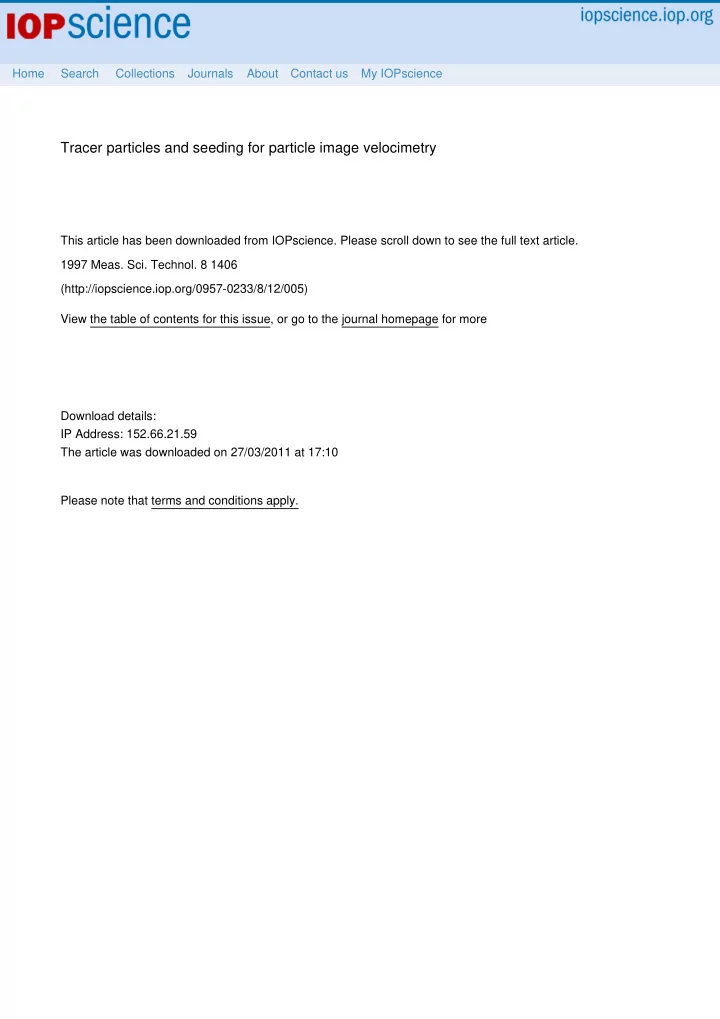

Home Search Collections Journals About Contact us My IOPscience Tracer particles and seeding for particle image velocimetry This article has been downloaded from IOPscience. Please scroll down to see the full text article. 1997 Meas. Sci. Technol. 8 1406 (http://iopscience.iop.org/0957-0233/8/12/005) View the table of contents for this issue, or go to the journal homepage for more Download details: IP Address: 152.66.21.59 The article was downloaded on 27/03/2011 at 17:10 Please note that terms and conditions apply.
Meas. Sci. Technol. 8 (1997) 1406–1416. Printed in the UK PII: S0957-0233(97)84480-3 Tracer particles and seeding for particle image velocimetry A Melling Lehrstuhl f¨ ur Str¨ omungsmechanik, Universit¨ at Erlangen-N¨ urnberg, Cauerstrasse 4, D-91058 Erlangen, Germany Received 28 May 1997, accepted for publication 2 October 1997 Abstract. The size specifications for suitable tracer particles for particle image velocimetry (PIV), particularly with respect to their flow tracking capability, are discussed and quantified for several examples. A review of a wide variety of tracer materials used in recent PIV experiments in liquids and gases indicates that appropriately sized particles have normally been used. With emphasis on gas flows, methods of generating seeding particles and for introducing the particles into the flow are described and their advantages are discussed. Table 1. The scattering cross section as a function of the 1. Introduction particle size. During the last decade, the technique of particle image Diameter d p Scattering cross section C s velocimetry (PIV, reviewed recently by Grant (1997)) ≃ 10 − 33 m 2 Molecule has seen rapidly increasing application for non-intrusive ≃ 10 − 12 m 2 C s ≃ ( d p /λ) 4 1 µ m diagnostic investigations of complex flow fields, both on ≃ 10 − 9 m 2 C s ≃ ( d p /λ) 2 10 µ m its own and as a complement to laser Doppler anemometry (LDA). Both methods rely on scattering particles suspended in the flow to provide the velocity information for the continuous medium (liquid or gas). The accuracy of the section 4 and methods of generating and seeding suitable velocity field determination is ultimately limited by the particles are described in section 5. ability of the scattering particles to follow the instantaneous motion of the continuous phase. A compromise between 2. Scattering characteristics of particles reducing the particle size to improve flow tracking and increasing the particle size to improve light scattering is, The choice of optimal diameter for seeding particles is a therefore, necessary (Melling and Whitelaw 1973). compromise between an adequate tracer response of the Proper flow seeding is particularly critical with PIV. particles in the fluid, requiring small diameters, and a high Even when using high laser pulse energies, the distribution signal-to-noise ratio (SNR) of the scattered light signal, of this energy over a laser sheet leads to an energy density necessitating large diameters. For the objectives of this which is low relative to that typical in LDA. Furthermore, paper, the tracking capability of the seeding particles is to secure sufficient detail in the flow field a higher spatial of greater concern, but light scattering characteristics of concentration of particles is generally needed than with particles are considered briefly in this section. LDA, with which it is possible (within limitations imposed A convenient measure of the (spatially integrated) light by flow unsteadiness, biased sampling of the velocity scattering capability is the scattering cross section C s , statistics or running costs) to wait indefinitely for the arrival defined as the ratio of the total scattered power P s to the of a scattering particle in the probe volume. There is also laser intensity I 0 incident on the particle: less scope in PIV for adjusting the position of the seeding source to optimize the data rate, so particle generators C s = P s /I 0 . (1) producing ample seeding are necessary. A uniform seeding size is desirable in order to avoid excessive intensity Figure 1 shows the variation of C s as a function of the ratio from larger particles and background noise, decreasing the of the particle diameter d p to the laser wavelength λ for accuracy, from small particles. spherical particles with a refractive index m = 1 . 6. Table 1 In the following sections, this paper will consider the compares approximate values for a diatomic molecule such specifications for PIV seeding particles with respect to light as nitrogen or oxygen and two larger particles. scattering characteristics (section 2) and the aerodynamic These examples indicate clearly the enormous dif- tracking capability (section 3). A review of the types ference between the light scattering cross sections of of particle used in various PIV applications is given in molecules and those of particles of diameter 1–10 µ m 0957-0233/97/121406+11$19.50 � 1997 IOP Publishing Ltd c
Recommend
More recommend